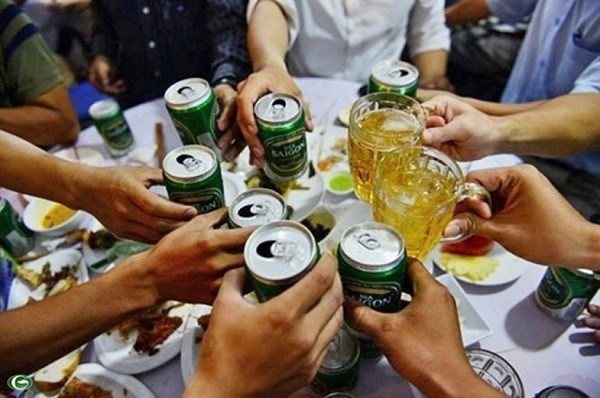Alcohol consumption increasing at alarming rate
Alcohol use is increasing at an alarming rate in Viet Nam, especially among young people, according to a conference held by the Ministry of Information and Communication in collaboration with the HealthBridge Organisation on July 5-6.
 |
| Viet Nam currently ranks second among Southeast Asian countries and third in Asia for alcohol consumption per person. (Photo: baovanhoa.vn) |
The three main criteria affected are average consumption per capita converted to pure alcohol, the rate of alcohol use in both sexes, and use at a harmful level.
Viet Nam currently ranks second among Southeast Asian countries and third in Asia for average alcohol consumption per person.
Nguyen Tuan Lam, an expert from the World Health Organisation (WHO), said that alcohol consumption is increasing rapidly in Viet Nam.
According to statistics from the 2018 Global Report, the average alcohol consumption/adult converted to pure alcohol increased from 3.8 litres/person (2005) to 8.3 litres in 2018, 6.4 litres higher than the world average.
Alcohol consumption in litres of pure alcohol per capita (over 15 years old) per year in Vietnam is 8.3 litres, equivalent to 170 litres of beer per year.
Dr Tran Quoc Bao, from the Department of Preventive Medicine under the Ministry of Health, said that the number of alcohol-related deaths was quite large. Alcohol use has been causing a heavy burden on health, the economy and increasing social problems.
According to the Ministry of Health, Viet Nam reports more than 548,000 deaths yearly from cancer, cardiovascular disease, mental, digestive, infectious and several other diseases. More than 40,800 deaths are estimated to be related to alcohol (accounting for 7.5%).
Alcohol use is also one of the causes of increasing gender and socio-economic inequalities, challenging efforts to reduce poverty sustainably, according to experts.
According to the 2021 Non-Communicable Disease Risk Factor Survey, the percentage of Vietnamese men who drink alcohol is very high.
Statistics have shown that in 2021, up to 64% of men and 10% of women have had alcohol in the past 30 days. Notably, drinking at dangerous levels has increased over the years, especially among men. One in three men drinks at dangerous levels.
Proposal to increase tax on beer and alcohol
It is estimated that the direct cost of alcohol consumption in Viet Nam in 2017 was 4 billion USD, equivalent to 7% of the State budget revenue, while the whole industry contributed about 50 trillion VND (equivalent to 2.14 billion USD) to the State budget.
“Alcohol tax currently is still low in Viet Nam. The proportion of tax on the retail price is only about 30%, while in many countries, the tax on alcohol accounts for about 40 to 85% of the retail price,” said Lam.
“The price of alcohol in Viet Nam currently is very cheap, and the purchasing power has increased sharply. One of the reasons is that the increase in alcohol prices is much slower than the growth in average income per capita yearly,” said Lam.
“If in 1998, to buy 10 litres of local vodka, domestic wine or domestic white wine, a person had to spend 8.2%; 5.9% and 1.6% of GDP/person/year. By 2014, the rates were only 2.2%, 1.6%, and 0.4%. The reduction is similar for beer.
“An increase of 20% in the price of alcohol can reduce alcohol consumption by 13% (a 10% decrease in beer consumption and 16% in spirits and wine consumption).”
The World Health Organization recommended tax policy as one of the most effective measures to control the harmful effects of alcohol and reduce the burden of disease and death caused by alcohol.
Experts from WHO, Ministry of Health and HealthBridge said that it was necessary to increase taxes to at least keep purchasing power from increasing and to increase taxes sharply to reduce purchasing power, thereby minimising the consequences of alcohol abuse for health the economy and society.
They said that increasing taxes to increase the price of alcohol products would bring many benefits to public health, the economy and society.
These benefits include reduced consumption, alcohol-related deaths and illnesses, medical costs, improved work efficiency, reduced social consequences of alcohol abuse and increased Government revenue. This is a mutually beneficial policy for the Government and the people.
In addition, the Government should also add an absolute tax and switch to a mixed tax mechanism to limit the weaknesses of proportional tax, such as transfer pricing and consumption shifting between products.
Research in low- and middle-income countries shows that restricting advertising and marketing of alcohol, especially beer, reduces the total amount of alcohol drank and average intake, according to Bao.
Source: VNA